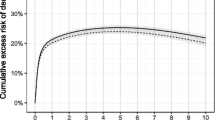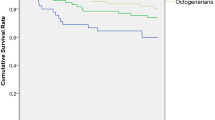Abstract
Summary
The relation between age and mortality after hip fracture was analyzed in elderly patients. 5.5% of the 31,884 patients died. Compared to those 65–74 years old, the multivariate OR for mortality for those 75–84 and ≥85 were 2.11 (95% CI: 1.61–2.77) and 4.10 (95% CI: 3.14–5.35).
Purpose
To analyze the impact of Elixhauser comorbidities on the relation between age and mortality after hip fracture in elderly patients.
Methods
Cross-sectional study of the population ≥65 years old hospitalized in Spain in 2013 with a diagnosis of fall-related hip fracture in the Basic Minimum Set Data (BMSD). The impact of Elixhauser comorbidities on the association between mortality and age groups (65–74, 75–84, ≥85) was analyzed by logistic regression models with progressive adjustment for demographic variables and comorbidities introduced individually.
Results
We identified 31,884 patients, 5.5% of which died during hospitalization. Compared with those 65–74 years old, the multivariate OR of mortality for those 75–84 and ≥85 years old decreased from 2.23 (95% CI: 1.71–2.90) and 4.57 (95% CI: 3.54–5.90) to 2.11 (95% CI: 1.61–2.77) and 4.10 (95% CI: 3.14–5.35), respectively after adjustment for comorbidities. The OR of mortality for men was 1.77 (95% CI: 1.58–1.98) compared to women. The comorbidities with higher OR for mortality were congestive heart failure (OR: 3.88; 95% CI: 3.42–4.41), metastasis (OR: 3.44; 95% CI: 2.27–5.20), fluid and electrolyte disorders (OR: 2.95; 95% CI: 2.47–3.52), coagulation deficiencies (OR: 2.87; 95% CI: 2.08–3.96), and liver disease (OR: 2.40; 95% CI: 1.82–3.17).
Conclusions
The association between age and mortality after hip fracture remains after adjusting for numerous comorbidities. However, some potentially controllable disorders are associated with an increased risk for mortality, thus, improving their management could benefit survival.
Similar content being viewed by others
Abbreviations
- BMDS:
-
basic minimum data set
- CI:
-
confidence interval
References
Parker M, Johansen A (2006) Hip fracture. BMJ 333:27–30
Melton LJ (2003) Adverse outcomes of osteoporotic fractures in the general population. J Bone Miner Res 18:1139–1141
Hindmarsh DM, Hayen A, Finch CF, Close JC (2009) Relative survival after hospitalisation for hip fracture in older people in New South Wales, Australia. Osteoporos Int 20:221–229. doi:10.1007/s00198-008-0641-z
Ministerio Sanidad Servicios Sociales e Igualdad (2014) Documento de consenso sobre prevención de fragilidad y caídas en la persona mayor. Ministerio Sanidad Servicios Sociales e Igualdad. Centro de Publicaciones. Madrid http://www.msssi.gob.es/profesionales/saludPublica/prevPromocion/Estrategia/docs/FragilidadyCaidas_personamayor.pdf. Accessed 31 August 2016.
Smith T, Pelpola K, Ball M, Ong A, Myint PK (2014) Pre-operative indicators for mortality following hip fracture surgery: a systematic review and meta-analysis. Age Ageing 43:464–471. doi:10.1093/ageing/afu065
Roche JJ, Wenn RT, Sahota O, Moran CG (2005) Effect of comorbidities and postoperative complications on mortality after hip fracture in elderly people: prospective observational cohort study. BMJ 331:1374. doi:10.1136/bmj.38643.663843.55
Tosteson AN, Gottlieb DJ, Radley DC, Fisher ES, Melton LJ (2007) Excess mortality following hip fracture: the role of underlying health status. Osteoporos Int 18:1463–1472
Castronuovo E, Pezzotti P, Franzo A, Di Lallo D, Guasticchi G (2011) Early and late mortality in elderly patients after hip fracture: a cohort study using administrative health databases in the Lazio region, Italy. BMC Geriatr 11:37
Paksima N, Koval KJ, Aharanoff G et al (2008) Predictors of mortality after hip fracture: a 10-year prospective study. Bulletin of the NYU Hospital for Joint Diseases 66:111–117
Hindmarsh D, Loh M, Finch CF, Hayen A, Close JC (2014) Effect of comorbidity on relative survival following hospitalisation for fall-related hip fracture in older people. Australasian journal on ageing 33:E1–E7. doi:10.1111/j.1741-6612.2012.00638.x
de Luise C, Brimacombe M, Pedersen L, Sorensen HT (2008) Comorbidity and mortality following hip fracture: a population-based cohort study. Aging Clin Exp Res 20:412–418
Elixhauser A, Steiner C, Harris DR, Coffey RM (1998) Comorbidity measures for use with administrative data. Med Care 36:8–27
Ministerio Sanidad Servicios Sociales e Igualdad (2011) Estudio de las comorbilidades que componen el índice de Elixhauser. Análisis de prevalencia y fiabilidad en los registros del CMBD estatal de hospitalización. Madrid. http://icmbd.es/docs/informe-comorbilidades-1.pdf. Accessed 31 August 2016.
Ministerio Sanidad Servicios Sociales e Igualdad (2015) Registro de altas- CMBD estatal. Hospitalización CMBD-H. Manual de definiciones y glosario de términos. Madrid. http://pestadistico.inteligenciadegestion.msssi.es Accessed 21 April 2016.
Franzo A, Francescutti C, Simon G (2005) Risk factors correlated with post-operative mortality for hip fracture surgery in the elderly: a population-based approach. Eur J Epidemiol 20:985–991. doi:10.1007/s10654-005-4280-9
Kannegaard PN, van der Mark S, Eiken P, Abrahamsen B (2010) Excess mortality in men compared with women following a hip fracture. National analysis of comedications, comorbidity and survival. Age Ageing 39:203–209. doi:10.1093/ageing/afp221
Mannucci PM (2008) Prophylaxis in congenital coagulation disorders: past, present and future. Blood Transfus 6(Suppl 2):S1–S3
Makris M (2012) Prophylaxis in haemophilia should be life-long. Blood Transfus 10:165–168. doi:10.2450/2012.0147-11
Bhat R, Cabey W (2014) Evaluation and management of congenital bleeding disorders. Emerg Med Clin 32:673–690
Adunsky A, Arad M, Koren-Morag N, Fleissig Y, Mizrahi EH (2012) Increased 1-year mortality rates among elderly hip fracture patients with atrial fibrillation. Aging Clin Exp Res 24:233–238
The Task Force for the Management of Atrial Fibrillation of the European Society of Cardiology (ESC) (2010) European society of cardiology guidelines. Eur Heart J 31:2369–2429. doi:10.1093/eurheartj/ehq278 http://eurheartj.oxfordjournals.org/content/ehj/31/19/2369.full.pdf
Besen BA, Gobatto AL, Melro LM, Maciel AT, Park M (2015) Fluid and electrolyte overload in critically ill patients: an overview. World J Crit Care Med 4:116–129
Brammar A, Nicholson A, Trivella M, Smith AF (2013) Perioperative fluid volume optimization following proximal femoral fracture. Cochrane Database of Systematic Reviews Issue 9. Art. No.: CD003004. doi: 10.1002/14651858.CD003004.pub3.
Trombetti A, Herrmann F, Hoffmeyer P, Schurch MA, Bonjour JP, Rizzoli R (2002) Survival and potential years of life lost after hip fracture in men and age-matched women. Osteoporos Int 13:731–737
Holt G, Smith R, Duncan K, Hutchison JD, Gregori A (2008) Gender differences in epidemiology and outcome after hip fracture: evidence from the Scottish hip fracture audit. J Bone Joint Surg 90:480–483
Yoshida S (2007). A Global Report on Falls Prevention. Epidemiology of Falls. Ageing and life course family and community health WHO. Geneva. http://www.who.int/ageing/projects/1.Epidemiology%20of%20falls%20in%20older%20age.pdf. Accessed 31 August 2016.
WHO (2007) WHO global report on falls prevention in older age. Ageing and life course family and community health WHO. Geneva. http://www.who.int/ageing/publications/Falls_prevention7March.pdf. Accessed 31 August 2016
Robbins JA, Biggs ML, Cauley J (2006) Adjusted mortality after hip fracture: from the cardiovascular health study. JAGS 54:1885–1891. doi:10.1111/j.1532-5415.2006.00985.x
Meyer HE, Tverdal A, Falch JA, Pedersen JI (2000) Factors associated with mortality after hip fracture. Osteoporos Int 11:228–232
Joseph B, Pandit V, Zangbar B, Kulvatunyou N, Hashmi A et al (2014) Superiority of frailty over age in predicting outcomes among geriatric trauma patients: a prospective analysis. JAMA Surg 149:766–772. doi:10.1001/jamasurg.2014.296
Fernandez-Ruiz M, Guerra-Vales JM, Trincado R, Medrano MJ, Benito-Leon J, Bermejo-Pareja F (2014) Hip fracture in three elderly populations of central Spain: data from the NEDICES study. Intern Emerg Med 9:33–41. doi:10.1007/s11739-011-0728-y
Stevens JA, Rudd RA (2014) Circumstances and contributing causes of fall deaths among persons aged 65 and older: United States, 2010. JAGS 62:470–475. doi:10.1111/jgs.12702
Cheng T, Zhang GY, Liu T, Zhang XL (2012) A meta-analysis of percutaneous compression plate versus sliding hip screw for the management of intertrochanteric fractures of the hip. J Trauma 72:1435–1443. doi:10.1097/TA.0b013e318247252a
Heetveld MJ, Rogmark C, Frihagen F, Keating J (2009) Internal fixation versus arthroplasty for displaced femoral neck fractures: what is the evidence? J Orthop Trauma 23:395–402
Williams A, Jester R (2005) Delayed surgical fixation of fractured hips in older people: impact on mortality. J Adv Nurs 52:63–69
Franzo A, Simon G, Francescutti C (2006) Mortality associated with delay in operation after hip fracture: but Italian data seem to contradict study findings. BMJ 332:1093
Author information
Authors and Affiliations
Corresponding author
Ethics declarations
Conflict of interest
Alicia Padrón-Monedero, Teresa López-Cuadrado, Iñaki Galán, Elena V. Martínez-Sánchez, Pilar Martin and Rafael Fernández-Cuenca declare that they have no conflict of interest.
Ethics approval
This study was approved by the Institutional Review Board of the Carlos III Institute of Health.
All procedures performed in studies involving human participants were in accordance with the ethical standards of the institutional and/or national research committee and with the 1964 Helsinki declaration and its later amendments or comparable ethical standards.
For this type of study formal consent is not required.
Rights and permissions
About this article
Cite this article
Padrón-Monedero, A., López-Cuadrado, T., Galán, I. et al. Effect of comorbidities on the association between age and hospital mortality after fall-related hip fracture in elderly patients. Osteoporos Int 28, 1559–1568 (2017). https://doi.org/10.1007/s00198-017-3926-2
Received:
Accepted:
Published:
Issue Date:
DOI: https://doi.org/10.1007/s00198-017-3926-2




